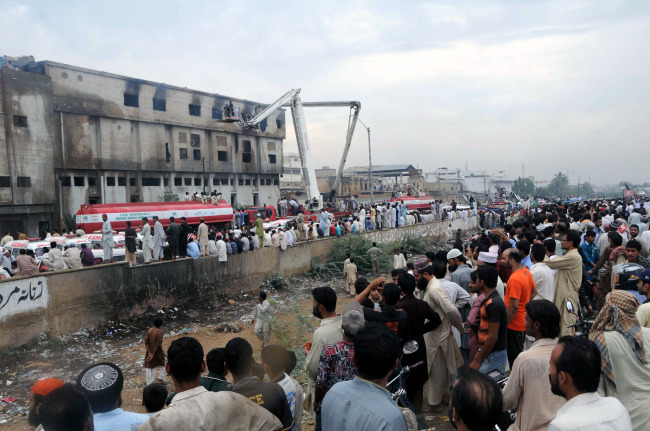KARACHI, Pakistan (AP) ― The death toll from a pair of devastating factory fires that broke out in Pakistan’s two biggest cities rose on Wednesday to 314 people, many of whom perished because they were unable to escape buildings that lacked emergency exits and basic safety equipment such as alarms and sprinklers.
The horrific toll highlights the atrocious state of industrial safety in Pakistan, where many factories are set up illegally in the country’s densely populated cities, and owners often pay officials bribes to ignore safety violations.
The more deadly of the two blazes, which both erupted on Tuesday night, was at a garment factory in the southern city of Karachi, the country’s economic heart.
The death toll there rose to 289 people Wednesday, as firefighters battled the flames for hours, said senior government official Roshan Ali Sheikh. It was one of the worst industrial accidents in Pakistan’s 65-year history, and Sheikh said the death toll could rise because rescue workers were still pulling bodies out from the site in Karachi.
 |
Pakistani firefighters conduct rescue operation at the garments factory in southern Pakistani port city of Karachi on Wednesday. (Xinhua-Yonhap News) |
Most of the deaths were caused by suffocation as people caught in the basement were unable to escape when it filled with smoke, said the top firefighter in Karachi, Ehtisham-ud-Din.
The building only had one accessible exit, and all the other doors were locked, said Sheikh.
“It is a criminal act to lock the emergency exit doors, and we are trying to know who did it, and why?” Sheikh said.
Relatives of the victims said the factory owner locked the exit doors in response to a recent theft, thereby endangering the workers inside.
“The owner of the factory should also be burned to death the way our dear ones have died in a miserable condition,” said Nizam-ud-Din, whose nephew died in the fire.
Workers on higher floors of the five-story building struggled to make it out of windows that were covered with metal bars. Many were injured when they jumped from the building, including a 27-year-old pregnant woman who was injured in the fall.
Another injured factory worker, Mohammad Ilyas, speaking from the hospital, said he was working with roughly 50 other men and women on one of the floors when suddenly a fireball came from the staircase.
“I jumped from my seat as did others and rushed toward the windows, but iron bars on the windows barred us from escaping. Some of us quickly took tools and machines to break the iron bars,” he said. “That was how we managed to jump out of the windows down to the ground floor.”
His leg was injured in the fall.
Others weren’t so lucky. An Associated Press reporter saw a charred body partially hanging out one of the factory’s barred windows. It appeared the victim tried to escape but couldn’t make it through the bars.
“There were no safety measures taken in the building design. There was no emergency exit. All the people got trapped,” said senior police official Amjad Farooqi.
The factory’s managers have fled and are being sought by police, Sheikh said, who is the senior government official in Karachi. He added that authorities have placed the name of the factory’s owner on the list of people who are not allowed to leave the country.
Also on Tuesday night, a fire swept through a four-story shoe factory in the eastern city of Lahore, killing 25 people. Some died from burns and others from suffocation, said senior police officer Multan Khan.
The factory was illegally set up in a residential part of the city. The fire broke out when people in the building were trying to start their generator after the electricity went out. Sparks from the generator made contact with chemicals used to make the shoes, igniting the blaze.
Pakistan faces widespread blackouts, and many people use generators to provide electricity for their houses or to run businesses.
One of the workers, Muhammad Shabbir, said he had been working at the factory for six months along with his cousin. He said all the chemicals and the generator were located in the garage, which was also the only way out of the building. When the fire ignited, there was no way to escape.
Shabbir said he had just gone outside the factory when the fire started, but his cousin was inside and was severely burned. He died at the hospital.
A firefighter at the scene, Numan Noor, said the reason most of the victims died was because the main escape route was blocked.








